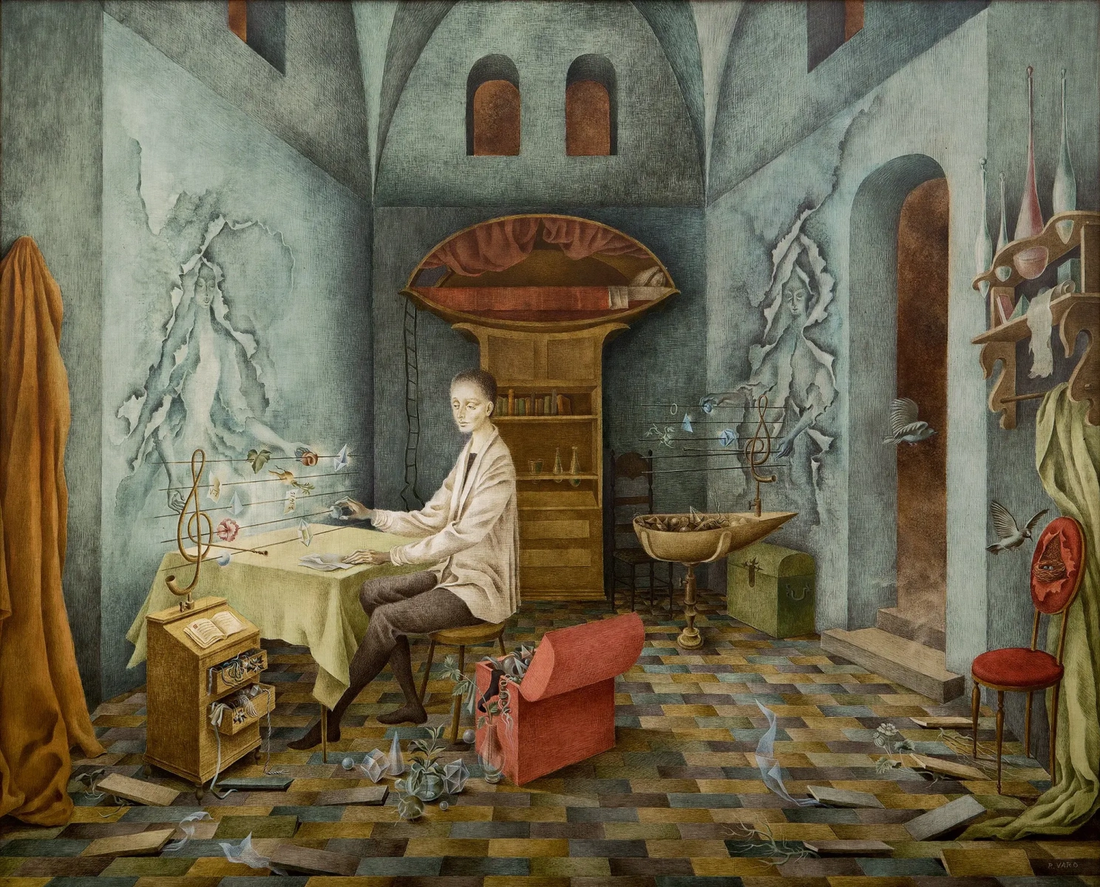
Remedios Varo: The Visionary Alchemist of Surrealism
Meg ☺Few artists have woven dreams into their canvases as masterfully as Remedios Varo. Born in 1908 in Spain and later finding her true artistic home in Mexico, Varo was a painter, mystic, and visionary whose surrealist works continue to captivate and inspire. Her art transcends mere imagery, offering a glimpse into a world shaped by science, philosophy, magic, and an enduring quest for self-discovery.

A Brief Historical Timeline
- 1908: Born in Anglès, Spain. Remedios was named in honor of the Virgen de los Remedios ("Virgin of Remedies") as a 'remedy' for an older sister's death.
- 1924-1930: Studied at the Real Academia de Bellas Artes de San Fernando in Madrid, a school known for rigid and exacting training. Aside from the required classes, she took an elective class in scientific drawing.
- 1930s: Became involved with the Spanish avant-garde and surrealist circles, including artist's José Luis Florit and Óscar Domínguez. While married to Lizárraga, she started a romantic relationship with Esteban Francés; the first of multiple open relationships she had.
-
1936: The Spanish Civil War erupted; Varo fled to Paris, which drastically shaped her path and art; deepening her connection with the Surrealists. It was in this context that Domínguez introduced Varo to French Surrealist poet Benjamin Péret, who had arrived in Barcelona in August 1936 to volunteer with the Republican faction. Péret was highly politically active and Varo and Péret soon became romantically involved. While in Paris with Péret, Varo lived the impoverished and bohemian life typical of artists. As she was living with Péret, she became romantically involved with Victor Brauner and her work of the period was heavily influenced by his.
Her association with the communist Péret put her at further risk, and he was imprisoned in early 1940 for his political activism. Varo was imprisoned as well, at some point in 1940, for her relationship with Péret. She never spoke about this experience; the length and location of her internment and the conditions she faced are unknown. However, according to friends' accounts, it had an intense impact on her.
- 1941: Escaped to Mexico with fellow artist Benjamin Péret, becoming part of an artistic community that included Leonora Carrington and Kati Horna.
- 1950s-1963: Her most prolific period, during which she produced her most well-known works, combining mystical, scientific, and esoteric elements.
-
1963: Passed away suddenly at the age of 54, leaving behind a body of work that continues to be studied and celebrated worldwide.

Bordando el manto terrestre (Embroidering the Earth's Mantle), 1961
Oil on Masonite, 39 3/8 × 48 7/16 in. (100 × 123 cm)
Influences: Artists, Thinkers, and Ideas
Family:
- Rodrigo Varo y Zejalvo (Remedios' Father). He was a hydraulic engineer, and his work led the family to travel frequently, which influenced Remedios Varo’s fascination with mechanics, precision, and scientific themes in her artwork. Varo's father encouraged her artistic endeavors, taking her to museums and having her meticulously copy his diagrams.
Artist Studies:
Scientists & Teachers:
- Carl Jung – Psychiatrist, psychotherapist, and psychologist who founded the school of analytical psychology. Prolific author, illustrator, and correspondent, and a complex and controversial character,
- George Gurdjieff — Philosopher, mystic, spiritual teacher, composer, and movements teacher.
- Pyotr Demyanovich Uspensky (known in English as P. D. Ouspensky) — Author and searcher of knowledge and wisdom.
- Helena Blavatsky — Mystic and writer who co-founded the Theosophical Society in 1875. She claimed that she encountered a group of spiritual adepts, the "Masters of the Ancient Wisdom", who sent her to Shigatse, Tibet, where they trained her to develop a deeper understanding of the synthesis of religion, philosophy, and science.

Planta Insumisa ("Rebellious Plant")
Philosophical Influences:

Painting Techniques:
- Decalcomania: This technique involves pressing a material, such as paper or glass, onto a painted surface and then removing it to create organic forms, patterns, and textures.
-
Soufflage: This technique involves applying paint in a very fluid consistency and then blowing air, often through a straw, to move the paint across the surface.
-
Grattage: A tecnique where paint is applied and then scraped with a textured object to create organic patterns, used by Varo to add intricate details.
- Sgraffito – A method of scratching through paint layers to reveal underlying colors and textures, creating depth and detail in her dreamlike compositions.
-
Layering of Thin Glazes: Varo applied thin layers of varnishes and glazes, combined with drips, blotting, and scratches, to create enormous depth and surface interest in her paintings.
- Meticulous Draftsmanship – Having studied technical drawing, Varo incorporated precise architectural and mechanical elements, giving her dreamlike worlds a logical structure.
- Automatic Mark Making: Influenced by Surrealist automatism, Varo engaged in automatic drawing to tap into the subconscious, allowing spontaneous imagery to emerge as a foundation for her detailed works.
-
Use of Quartz Crystals: According to recent research by Tere Arcq, Varo is believed to have scored her hardboard panels with quartz crystals, creating tiny incisions across the surface. This technique allowed for a denser application of paint, adding depth and texture to her works.
Remedios Varo's art is an invitation to explore the liminal space between reality and imagination, science and magic, the known and the unknown. Her paintings are portals into a world where the alchemist, the dreamer, and the seeker are one and the same. For those enchanted by the ethereal, Varo’s work remains a testament to the boundless potential of the human spirit, forever searching, forever evolving.

Astro Errante ("The Wandering Star")

The word “Remedios” is Spanish, and its direct translation into English is “remedies.”
It comes from the Latin remedium, meaning "cure" or "means of healing." In Spanish, it can also carry the sense of "solutions" or "ways to fix a problem," depending on the context.
So:
Literal meaning: remedies, cures.
Figurative meaning: solutions, ways out, relief.
Sources & Credits:
https://en.wikipedia.org/wiki/Remedios_Varo
ChatGPT



